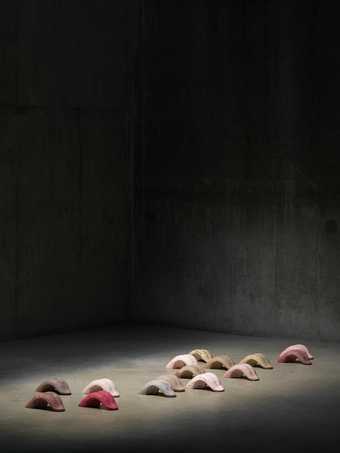This display stages a conversation between three works by women artists, centred on the relationship between the body and the earth, and cycles of regeneration
In Mendieta’s Grass Breathing, a stretch of turf gently rises and falls in a rhythm of breath, set in motion by the artist’s concealed body. It is part of a series of short films the artist made in the 1970s and 1980s which depict ephemeral performances in outdoor landscapes using the artist’s own body. These ‘earth-body’ works evoke a connection between the human form and the living earth. Mendieta related the feeling of leaving her home in Cuba to move to the US when she was young to being ‘cast from the womb (Nature)’. She called her artmaking a ‘return to the maternal source.’
The pillow of Ryan’s Relics in the Pillow of Dreams supports a set of bronze, pod-like 'relics’. They sit in its indentations, seemingly about to sprout from them. Both pillows and pods, as well as nuts, fruits and seeds, reappear throughout Ryan’s sculptures. These at times reference fruit from the Caribbean island of Montserrat, where Ryan spent her childhood before moving to the UK. Here, the soft-seeming pillow is placed close to the earth, acting as a link through which time-past (through the bronze ‘relics’) and time-future (through the possibility of dreams) meet.
Interested in the fragility of matter and its capacity to deteriorate and change, Põder used materials such as wax, glue, soap and honeycomb for her works from the 1970s onwards. Her Tongues (Activation Version) recall the artist’s childhood memories on an Estonian farm, where women would boil grease and caustic soda to mould soap – like the process of casting in sculpture. Here, a soap tongue slowly disintegrates in a bowl of water to be remade again, in a cycle of decay and regeneration.

